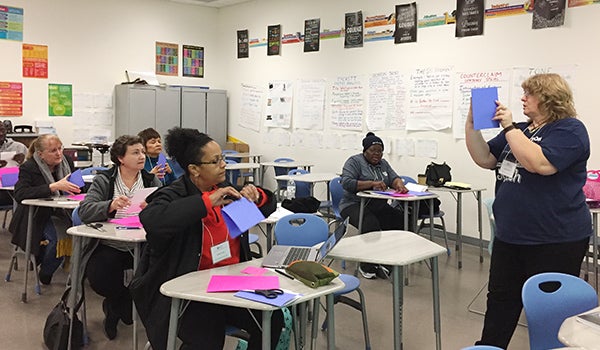The Rice University School Mathematics Project (RUSMP) celebrated Black History month at its annual Spring Networking Conference by honoring African American mathematician and scientist Benjamin Banneker at Milby High School.
Brea Ratliff, president of the Benjamin Banneker Association, Inc., presented the thought-provoking keynote, “Building Like Banneker: Using History and Culturally Responsive Pedagogy to Shape Positive Mathematics Identities.” The Benjamin Banneker Association, Inc. and Luchin Educational Consulting generously underwrote the conference breakfast.

Benjamin Banneker (1731–1806) was known for his work in many scientific disciplines, all of them self-taught. His accomplishments included creating a clock made completely of wood, assisting in the surveying of the District of Columbia and creating a series of mathematical puzzles that have intrigued students for years.
The Benjamin Banneker Association, Inc. is a national nonprofit organization and partner affiliate with the National Council of Teachers of Mathematics. The association is dedicated to mathematics education advocacy, establishing a presence for leadership and professional development to support teachers in leveling the playing field for mathematics learning of the highest quality for African American students.
Milby art students honored Banneker by studying his life and creating artwork based on his scientific accomplishments. The artworks were displayed at the conference, and attendees voted for their favorite piece of art. In addition, Patricia McMorris, the Milby math chair and National Science Foundation (NSF) Noyce Fellow, selected junior and senior Milby student ambassadors from the National Honor Society to assist with the conference setup, direct attendees to various locations on campus and assist the keynote speaker.
After the keynote presentation, there were 12 breakout sessions led by fellows from Rice University’s National Science Foundation Robert Noyce Master Teaching Fellowship Program (Grant No 1556006). The sessions offered a variety of content and pedagogical topics, including how to develop a classroom website, how to use screen casting in instruction, how to integrate GeoGebra to develop visually rich interesting lessons and how to make historical connections in geometry. Material in the presentations was based on work supported by the NSF.
The conference was a tremendous success. One attendee stressed the importance of conferences such as this one: “I enjoy the opportunity to engage with other educators in meaningful ways. Both the keynote presentation and the breakout sessions provided me with ideas that I can immediately use in my classroom.” Another attendee said, “The presentation about Benjamin Banneker deepened my thinking and changed my outlook as a mathematics teacher.”
— Richard Parr
Executive Director
Rice University
School Mathematics Project

